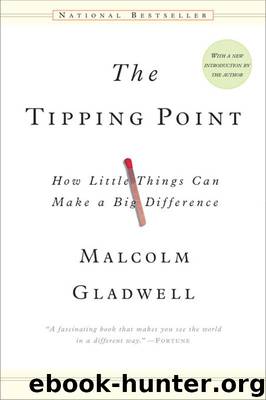The Tipping Point: How Little Things Can Make a Big Difference by Gladwell Malcolm

Author:Gladwell, Malcolm [GLADWELL, MALCOLM]
Format: epub, mobi, azw3
Tags: BUS000000
ISBN: 9780759574731
Publisher: Little, Brown and Company
Published: 2006-11-01T04:00:00+00:00
4.
In chapter 2, when I was discussing what made someone like Mark Alpert so important in word of mouth epidemics, I talked about two seemingly counterintuitive aspects of persuasion. One was the study that showed how people who watched Peter Jennings on ABC were more likely to vote Republican than people who watched either Tom Brokaw or Dan Rather because, in some unconscious way, Jennings was able to signal his affection for Republican candidates. The second study showed how people who were charismatic could—without saying anything and with the briefest of exposures—infect others with their emotions. The implications of those two studies go to the heart of the Law of the Few, because they suggest that what we think of as inner states—preferences and emotions—are actually powerfully and imperceptibly influenced by seemingly inconsequential personal influences, by a newscaster we watch for a few minutes a day or by someone we sit next to, in silence, in a two minute experiment. The essence of the Power of Context is that the same thing is true for certain kinds of environments—that in ways that we don’t necessarily appreciate, our inner states are the result of our outer circumstances. The field of psychology is rich with experiments that demonstrate this fact. Let me give you just a few examples.
In the early 1970s, a group of social scientists at Stanford University, led by Philip Zimbardo, decided to create a mock prison in the basement of the university’s psychology building. They took a thirty five foot section of corridor and created a cell block with a prefabricated wall. Three small, six by nine foot cells were created from laboratory rooms and given steel barred, black painted doors. A closet was turned into a solitary confinement cell. The group then advertised in the local papers for volunteers, men who would agree to participate in the experiment. Seventy five people applied, and from those Zimbardo and his colleagues picked the 21 who appeared the most normal and healthy on psychological tests. Half of the group were chosen, at random, to be guards, and were given uniforms and dark glasses and told that their responsibility was to keep order in the prison. The other half were told that they were to be prisoners. Zimbardo got the Palo Alto Police Department to “arrest” the prisoners in their homes, cuff them, bring them to the station house, charge them with a fictitious crime, fingerprint them, then blindfold them and bring them to the prison in the Psychology Department basement. Then they were stripped and given a prison uniform to wear, with a number on the front and back that was to serve as their only means of identification for the duration of their incarceration.
The purpose of the experiment was to try to find out why prisons are such nasty places. Was it because prisons are full of nasty people, or was it because prisons are such nasty environments that they make people nasty? In the answer to that question is
Download
The Tipping Point: How Little Things Can Make a Big Difference by Gladwell Malcolm.mobi
The Tipping Point: How Little Things Can Make a Big Difference by Gladwell Malcolm.azw3
This site does not store any files on its server. We only index and link to content provided by other sites. Please contact the content providers to delete copyright contents if any and email us, we'll remove relevant links or contents immediately.
| Advertising | Consumer Behavior |
| Customer Service | Marketing |
| Public Relations | Sales & Selling |
| Search Engine Optimization |
Influence: The Psychology of Persuasion by Robert B. Cialdini(4715)
The Miracle Morning by Hal Elrod(4637)
The Hacking of the American Mind by Robert H. Lustig(4318)
Pre-Suasion: A Revolutionary Way to Influence and Persuade by Robert Cialdini(4144)
Unlabel: Selling You Without Selling Out by Marc Ecko(3587)
Ogilvy on Advertising by David Ogilvy(3503)
Hidden Persuasion: 33 psychological influence techniques in advertising by Marc Andrews & Matthijs van Leeuwen & Rick van Baaren(3472)
Purple Cow by Seth Godin(3137)
Who Can You Trust? by Rachel Botsman(3086)
Kick Ass in College: Highest Rated "How to Study in College" Book | 77 Ninja Study Skills Tips and Career Strategies | Motivational for College Students: A Guerrilla Guide to College Success by Fox Gunnar(3070)
The Marketing Plan Handbook: Develop Big-Picture Marketing Plans for Pennies on the Dollar by Robert W. Bly(2975)
This Is Marketing by Seth Godin(2969)
I Live in the Future & Here's How It Works by Nick Bilton(2934)
The Power of Broke by Daymond John(2896)
Building a StoryBrand by Donald Miller(2839)
The Tipping Point by Malcolm Gladwell(2824)
The 46 Rules of Genius: An Innovator's Guide to Creativity (Voices That Matter) by Marty Neumeier(2796)
Draw to Win: A Crash Course on How to Lead, Sell, and Innovate With Your Visual Mind by Dan Roam(2732)
Market Wizards by Jack D. Schwager(2643)
